&& is a logical operator. This tests whether a value is truthy or falsy. This linked article explains that falsy values are equal to undefined, null, NaN, 0, "" and false.
Logical expressions are checked from left to right. If any part of the expression is evaluated t be falsy, the remainder of the expression will not be evaluated. In your examples, the value is always truthy. Here we can break down your first expression:
f = 1 && 2 && 3;
f = 1 /* Okay, 1 is a truthy value, lets continue... */
f = 2 /* Still truthy, let's continue... */
f = 3 /* Still truthy, we've reached the end of the expression, f = 3. */
If any of the values before 3 were falsy, the expression would have ended. To show this in action, simply redeclare your variable as:
f = 1 && 2 && 0 && 3;
Here 0 is a falsy value (as mentioned above). The execution of your expression here will end at 0:
f = 1 /* Okay, 1 is a truthy value, lets continue... */
f = 2 /* Still truthy, let's continue... */
f = 0 /* Hey, this is falsy, lets stop here, f = 0. */
f = 3 /* We never get here as the expression has ended */
Here f ends up being 0.
In your jQuery.Topic() example, && is used to ensure that id actually exists:
topic = id && topics[id]
We can break this down in the same way:
/* Assume this is your topics array: */
topics = ["", "My First Topic", "My Second Topic"];
/* If we pass in the value 1 as "jQuery.Topic(1)": */
topic = id && topics[id]
topic = 1 /* This is truthy, let's continue... */
topic = topics[1] /* topics[1] === "My First Topic" */
/* Now lets assume we pass in nothing as "jQuery.Topic()": */
topic = id && topics[id]
topic = null /* This is falsy, let's stop here, topic = null. */
The following if statement will only work if topic is truthy. In the first example, this is the case as topic has a value which is set to a string which isn't empty. In the second example, topic is null which is falsy.
